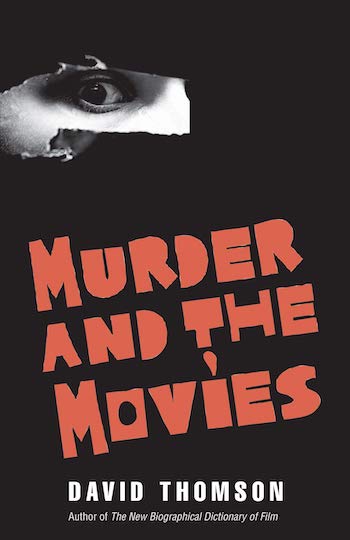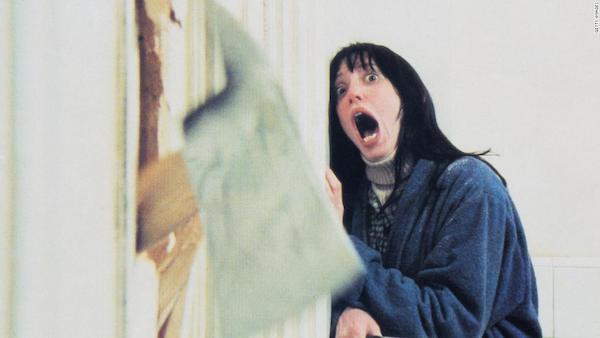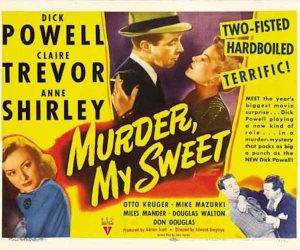Book Review: “Murder and the Movies” — So Cinematic, the Spectacle of Death
By Lucas Spiro
Our awareness of our delight in the homicidal temptations presented by film is itself a kind of twisted comedy that the critic is all too aware of.
 Murder and the Movies by David Thomson. Yale University Press, 240 pages, $26.
Murder and the Movies by David Thomson. Yale University Press, 240 pages, $26.
Click here to buy
Go on, admit it. You know you’ve said it. Maybe even half-meant it, once. Twice? I know you’ve said it because we’ve all said it. “I could kill you.” But you didn’t go through with it, did you? Why not? Because you’re not a murderer. You’re probably a halfway decent person or, if not halfway decent, no more wretched than the rest of us. You read the Arts Fuse, after all. Maybe, just maybe, you’re an accidental killer. Does that put you in the ballpark? I wouldn’t know. But, hey, accidents happen. That doesn’t make you a murderer.
You probably enjoy watching or reading a good murder now and again, though. Who doesn’t? Perhaps a vengeful evisceration, a salacious slaying, a barbaric butchering, or just a good old-fashioned cold-blooded killing. You might even like it in the afternoons. Scan your bookshelves and count the Christies, Hammetts, Highsmiths, Chandlers, and Kings. Scroll through your favorites on Netflix and tell me I’m wrong. Between Ozark and Breaking Bad you’ll find Hitchcock, Scorsese, Kubrick, and Fincher all delighting us with their gorgeous killings. How many deaths have you witnessed this week? Don’t be ashamed. It’s this bingeing — which we’re all guilty of –that inspired writer and film historian David Thomson to write his new, deeply affecting, humorously insightful, and deadly serious book Murder and the Movies.
No judgment here, I promise. Thomson isn’t rehashing hysteria à la Tipper Gore, whose puritanical edicts probably only boosted sales of Twisted Sister and Jello Biafra. Thomson is interested in a more personal exploration, though with wide-reaching implications because of cinema’s power as a mass medium. Beginning with a few simple reflections, Thomson draws on his deep reservoir of cinematic history, formalist criticism, and subjective observation to shape an existential inquiry into loneliness and its prevalence in modern Western culture. His argument is not about movies — it works through movies. The irony is that in this book Thomson accomplishes what the best films pull off. He entertains, yes, but he also forces us to reflect critically about ourselves and our place in the world. It’s another compelling achievement in the career of one of cinema’s most significant audience members.
At this point, Thomson is probably among the most influential film critics writing in English. His major contributions include the constantly updated The New Biographical Dictionary of Film (now on something like it’s sixth edition). He’s also a bit of a holdover from a previous era in criticism, when you could make a living writing serious yet accessible arts journalism. Much of today’s movie reviewing is committed by an army of unimaginative film school attendees (holding forth on formalism via YouTube) or ideologically motivated writers like Zizek and Mark Fisher. Thomson, like Clive James and Roger Ebert, were/are respected critics. Yet they were never so intimidating that they couldn’t be welcomed into our living rooms on TV. Film’s disparate shapes – artistic vision, capitalist endeavor, popular medium, subjective experience – have forced its best evaluators to be accessible yet expansive, to invite the public into discussions of aesthetic form, moral standards, and entertainment value.
The notion of morality has driven some critics into trying to control what’s considered acceptable “cinema,” out of fear that too many of us will emulate the immoral actions (particularly the excessive violence) they see on film. The Motion Picture Production Code, or “Hays” Code, which ushered in a new era of films and filmmaking, ultimately only strengthened the trend away from censorship. Here’s Thomson on the “forbidden fruit” dynamic:
The commercial momentum of film going identified its natural thematic material: situations of danger or suspense that did not actually threaten audiences; windows of sexual allure that did not immediately take spectators (mostly male) into the divorce courts; and tests of epic violence in which law-abiding cowards in the dark could feel they had fought for virtue and justice. But as the business became a sensation there were warnings from reputable society about the indecent stress on fantasy in what was called cinema…
…The history of censorship reflected that urge for guardianship, but the safeguarding codes would also permit the movies to depict the falling veils of nakedness and the steps toward murder without theatres being closed down. You can call this demoralization, or you can see it as the tricky playfulness that movies ushered in. Censorship has always been a subgenre in movies…
In every instant, good cinema is saying, no, you can’t see this, you really shouldn’t.
This contradictory imperative of film – to look at what ought not be seen – is the phenomenological playground that attracts practitioners and audience members. Even if cinema is, as Jean-Luc Godard put it, “the truth 24 frames per second,” we also trust that it’s a mirage, a true fake, a contrivance whose artifice is intelligible. The audience is passive, yes, but with a privileged view. We have to actively be taken in by what we see through strips of celluloid. To define and analyze this perspective Thomson guides us to the icy haunt of the Rocky Mountains and The Overlook Hotel.

Shelley Duvall as a terrified Wendy Torrance in 1980’s The Shining.
Thomson likens the hotel setting of Stanley Kubrick’s masterful (if not entirely faithful) interpretation of Stephen King’s The Shining to “a large, well-appointed theater, waiting for an audience or a movie.” Such theaters offer an “enchanted air, the mix of spatial splendor and secret (or as yet unrevealed) promise.” The Overlook’s name, Thomson says, “ought to help us feel a metaphor for a movie house, a place where our spectatorship is never in jeopardy.” The audience’s passivity (what is going to happen next?) collaborates with the director’s authorial command. Viewers are like accomplices, asked to enjoy the creator’s imperious vision without taking any responsibility for its ethics. “An empty theatre is like Creation without the juice of purpose of desire,” Thomson continues. “[a]t the Overlook, you’ll have the best view but you will be ‘over’ it, above it. You’ll be able to watch and imagine without having to intervene or feel culpable.”
But they’re just movies, right? It’s just entertainment, harmless diversion. In many ways, yes. The business of movies was booming (before the pandemic), but their cultural significance has atrophied over the past few decades. A Marvel Comics epic can make a billion dollars and register zero impact on our collective and personal psychologies, our politics, etc. (You could argue that is their “impact.”) Thomson sometimes overstates his concerns about what happens when we witness killings, albeit beautiful and horrific, in superhero films. After the writer’s teenage son explains to him what an incel is (involuntary celibate), Thomson naively wonders about the influence of Joker on an increasingly alienated population. But the critic is wise not to venture too far down this line of vacant — and empirically dubious — moralizing.
It’s tempting though. One need only think of the recent images of a trans woman being beaten and robbed in Hollywood. A person with a camera records the incident on the empty, pandemic-era streets as if the area were cordoned off for shooting. The woman didn’t die, thankfully, but she appeared dead. Meanwhile, people stood around and shot the scene on their phones: the names of iconic dead celebrities — carved into the stars on the Walk of Fame stars on Hollywood Boulevard — served as a harrowing ingredient in the mise-en-scène. And what about the countless images of Black people being murdered by cops? How many of those do we see before we are angered to take action? How many of us are no longer affected by footage of a police killing? What’s one more once we have seen so many?
 But, as I mentioned earlier, Thomson’s work is deeply personal. It’s almost as if he feels he would be negligent if he didn’t at least comment on the countless murders he’s witnessed and that shaped his approach as a film critic. His real subject in Murder and the Movies is an examination of the internal: abstract desires or visceral impulses that film makes visible. It’s also about a fear that each of us feels alone (even when we are surrounded by others in a theater). He’s talking about death. Not just death in general, but his own. And mine. And yours. And how movie murders are, on the one hand, about death as a commonplace. Death is a universal equalizer, something we will undergo alone. Yet, on the other hand, “murder in the movies is a kind of theater meant to defy our own ordinary fate.”
But, as I mentioned earlier, Thomson’s work is deeply personal. It’s almost as if he feels he would be negligent if he didn’t at least comment on the countless murders he’s witnessed and that shaped his approach as a film critic. His real subject in Murder and the Movies is an examination of the internal: abstract desires or visceral impulses that film makes visible. It’s also about a fear that each of us feels alone (even when we are surrounded by others in a theater). He’s talking about death. Not just death in general, but his own. And mine. And yours. And how movie murders are, on the one hand, about death as a commonplace. Death is a universal equalizer, something we will undergo alone. Yet, on the other hand, “murder in the movies is a kind of theater meant to defy our own ordinary fate.”
In order for Thomson to get you to look at murder and film from a fresh perspective he has to enter that theater, visit the Overlook and withstand its icy isolation. And that journey is part of the book’s appeal as a kind of antic speculation. Thomson draws on his distinctive voice — authoritative, witty, confessional, provocative — to analyze cinema’s playful interweaving of “desire” and “control,” its confrontation with our terror of extinction, its self-conscious mix-and-match of comedy and tragedy. Our awareness of our delight in the homicidal temptations presented by film is itself a kind of twisted comedy that the critic is all too aware of. Thomson invites us to laugh along as he guides us through our favorite murders and movies, always urging us to remember that “they shoot movies, don’t they?”
Lucas Spiro is a writer living in Dublin.
